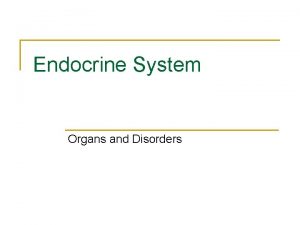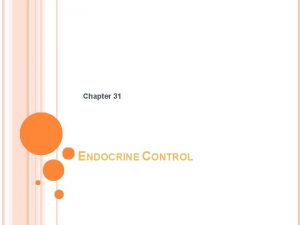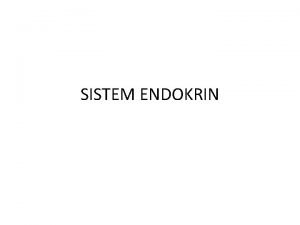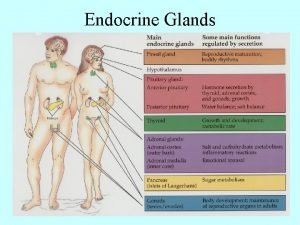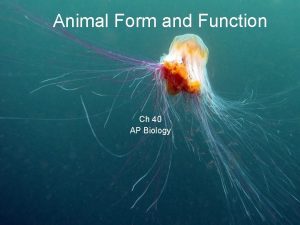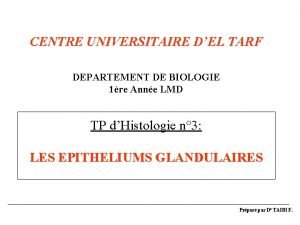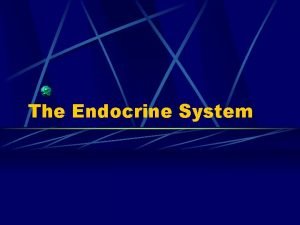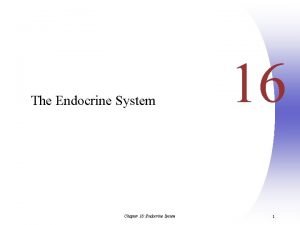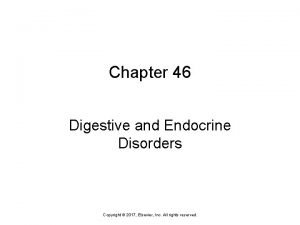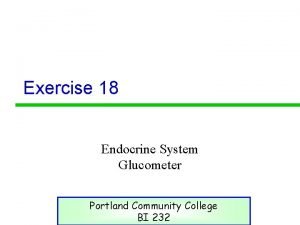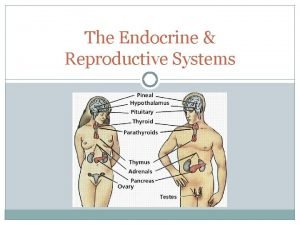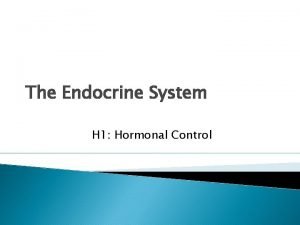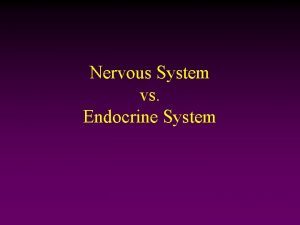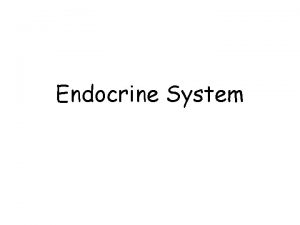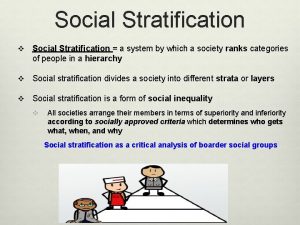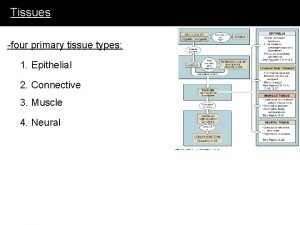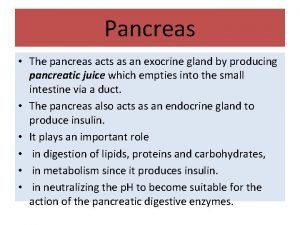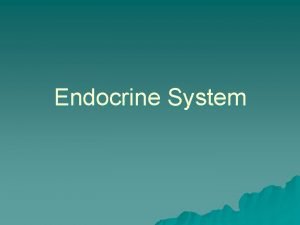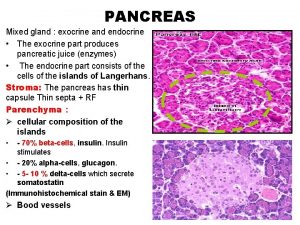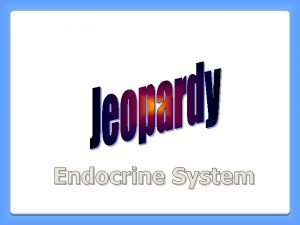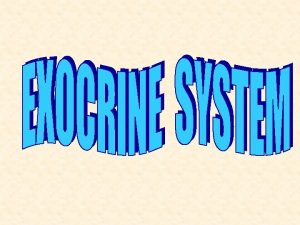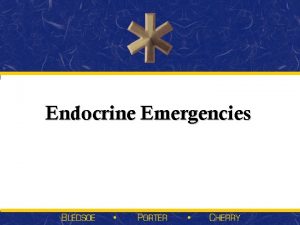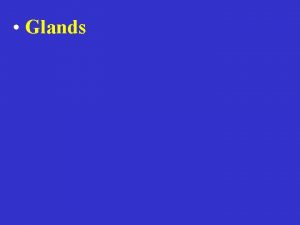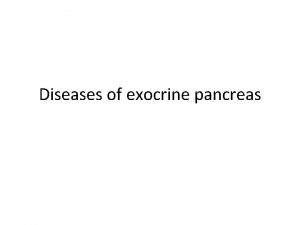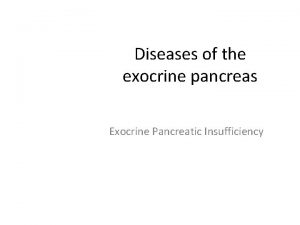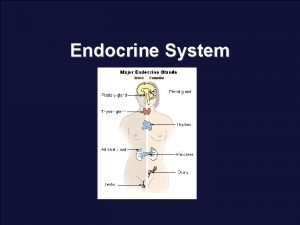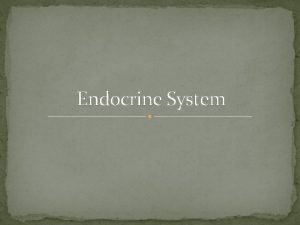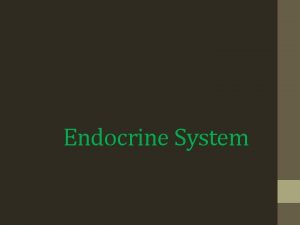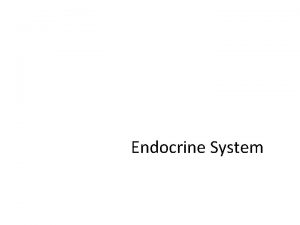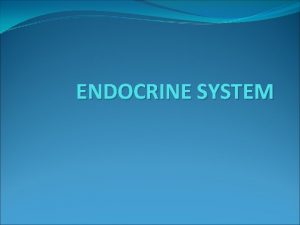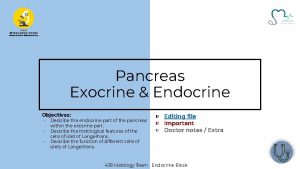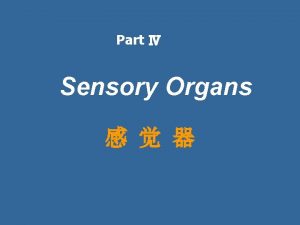Endocrine System Organs and Disorders Endocrine versus Exocrine




















- Slides: 20

Endocrine System Organs and Disorders

Endocrine versus Exocrine glands n Endocrine –ductless, releases hormones into intercellular space such as the blood stream q n Hypothalamus, pituitary gland Exocrine –releases contents into ducts or outside body q Ex. Sweat glands, sebaceous glands

Steroid versus protein hormone n Steroid –hormone that is lipid soluble, does through cell membrane of target organ to nucleus. n Protein (non-steroid) – hormone that needs a 2 nd messenger to send message to nucleus since it can not go through cell membrane on its own.

Protein Hormone Steroid Hormone

Homeostasis

n Prostaglandin –tissue hormones – produced in tissue and only travels short distance n Hormone – chemical messenger released by gland travels to target organ via the blood n Tropic Hormone – hormone that stimulates another endocrine gland to secrete hormones Ex. TSH, FSH n

Pituitary Gland n n Lies deep in brain, attached to hypothalmus Anterior pituitary – adenohypophysis (gland) q Tropic hormones – stimulates another endocrine gland to secrete hormone n n q q Thyroid stimulating hormone (TSH)– thyroid Adrenocorticotropic hormone –(ACTH) adrenal cortex Follicle-stimulating hormone (FSH) – ovarian follicles Luteinizing Hormone (LH)- ovulating hormone Growth hormone – promotes normal growth Prolactin – lactogenic hormone (breast development for lactation)

Disorders of AP n Growth hormone q Hypersecretion – gigantism, Acromegaly, hyperglycemia q n Hyposecretion – dwarfism Prolactin q q Hyper – inappropriate lactation in men and nonnursing women Hypo – insufficient lactation in nursing women

Posterior pituitary n n Antidiuretic hormone (ADH) – reabsorption of water from urine in kidney to blood, decrease urine volume Oxytocin – stimulates contraction of smooth muscle of uterus, initiate and maintain labor, stimulates milk letdown

Disorders of PP n ADH q q n Hyper – abnormal water retention Hypo – diabetes insipidus – elimination of too much urine – dehydration Oxytocin q q Hyper – increase milk flow Hypo – prolonged labor

Hypothalmus n n n Produces ADH and oxytocin (PP only releases them) Releasing hormones – stimulates Anterior pituitary to release hormones Inhibiting hormones – Inhibits anterior pit. release of hormones Hypothalmus functions in nervous and endocrine systems – dominant role in regulation of many body functions: body temp, appetite, thirst

Thyroid n n Thyroxine (T 4) and Triiodothyronine (T 3) – speed up cells release of energy from foods, stimulate cellular metabolism Calcitonin – maintains homeostasis of blood calcium, decreases the amount of calcium in the blood, act on bone to inhibit its breakdown, therefore calcium does not move out of bone.

Thyroid disorders n Hyperthyroidism, increase metabolic rate, lose weight, restless, excessively active n n n Exophthalmus – protruding eyes Graves disease – inherited, hyperthyroidism, bulging eyes Hypothyroidism – under secretion of TH q q q Goiter – low intake of iodine, enlargement of thyroid to compensate for lack of iodine Cretinism – low metabolic rate, retarded growth and sexual development Myxedema – lessened mental and physical vigor, weight gain, loss of hair, accumulation of mucous fluid (eyes)

Parathyroid glands n n Posterior of thyroid, Usually 4, small parathyroid hormone – increase concentration of calcium in blood (opposite of calcitonin) fig. 11 -12 Hyper – hypercalcemia Hypo - hypocalcemia

Adrenal Glands – top of kidneys n Adrenal cortex – outer part, corticoids q Mineralocorticoids, MC’s – aldosterone n q Glucocorticoids (cortisol, hydrocortisone) n q Control mineral salts in blood (increase sodium, decrease potassium) Maintain normal glucose concentration and blood pressure Sex hormones

Adrenal Medulla n n Inner portion of adrenal gland Epinephrine, Norepinephrine – secreted during stressful situations, works with sympathetic nervous system (adrenaline)

Adrenal disorders n Hypersecretion of GC’s – usually because of a tumor – Cushing syndrome q n Hypersecretion in inner zone – sex hormones called androgens, results in secondary sex characteristics q n Moon face, buffalo bump due to redistribution of body fat, can remove tumor In women, caused by virilizing tumor Hyposecretion of adrenal cortex - Addison disease – muscle weakness, low blood sugar

Pancreatic islets – islets of Langerhans n n n Scattered among pancreatic cells in pancreas Glucagon – increases the blood glucose concentration Insulin – decreases blood glucose concentration by moving it out of the blood q q Hypersecretion - hypoglycemia Hyposecretion - type 1 diabetes mellitus – high glucose levels in blood n Type 2 diabetes – abnormality of insulin receptors

Additional endocrine glands n Ovary q q n Testes q n Ovarian follicles – estrogen, feminizing hormone Corpus luteum – progesterone Testosterone – masculinizing hormone Thymus – in mediastinum, contains WBC’s q Thymosin – several hormones that play in important role in the development and function of the body’s immune system

More endocrine glands… n Placenta – temporarily produce hormones q n Chorionic ganadotropins (pregnancy test indicators), estrogen, progesterone Pineal gland – near 3 rd ventricle in brain q Melatonin – regulates puberty and menstrual cycle in females n n 3 rd eye – optic nerve, increase at night, internal clock and sleep cycle, supplements help to sleep SAD – seasonal affective disorder – high levels
 Kliere
Kliere Difference between endocrine and exocrine glands
Difference between endocrine and exocrine glands Whats the difference between endocrine and exocrine glands
Whats the difference between endocrine and exocrine glands Mekanisme kerja master gland contohnya
Mekanisme kerja master gland contohnya Endocrine exocrine
Endocrine exocrine Ap biology chapter 40
Ap biology chapter 40 Glande endocrine exocrine
Glande endocrine exocrine Endocrine vs exocrine
Endocrine vs exocrine Endocrine
Endocrine Chapter 46 digestive and endocrine disorders
Chapter 46 digestive and endocrine disorders Chapter 29 endocrine and metabolic disorders
Chapter 29 endocrine and metabolic disorders Endocrine organs
Endocrine organs Endocrine system and reproductive system
Endocrine system and reproductive system Endocrine system and nervous system
Endocrine system and nervous system Endocrine system and nervous system
Endocrine system and nervous system Lymphatic system vs endocrine system
Lymphatic system vs endocrine system General mechanism of hormone action
General mechanism of hormone action Caste vs class
Caste vs class Caste system versus class system
Caste system versus class system Four primary tissue types
Four primary tissue types Action of pancreatic juice
Action of pancreatic juice
